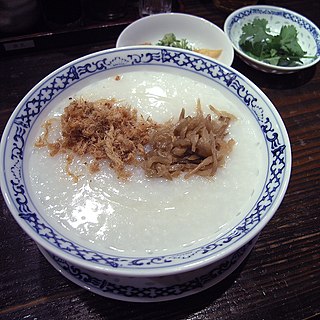Furigana is a Japanese reading aid consisting of smaller kana printed either above or next to kanji or other characters to indicate their pronunciation. It is one type of ruby text. Furigana is also known as yomigana (読み仮名) and rubi in Japanese. In modern Japanese, it is usually used to gloss rare kanji, to clarify rare, nonstandard or ambiguous kanji readings, or in children's or learners' materials. Before the post-World War II script reforms, it was more widespread.
Hiragana is a Japanese syllabary, part of the Japanese writing system, along with katakana as well as kanji.

Japanese is the principal language of the Japonic language family spoken by the Japanese people. It has around 123 million speakers, primarily in Japan, the only country where it is the national language, and within the Japanese diaspora worldwide.
Katakana is a Japanese syllabary, one component of the Japanese writing system along with hiragana, kanji and in some cases the Latin script.
Kana are syllabaries used to write Japanese phonological units, morae. In current usage, kana most commonly refers to hiragana and katakana. It can also refer to their ancestor magana, which were Chinese characters used phonetically to transcribe Japanese ; and hentaigana, which are historical variants of the now-standard hiragana.

Kanji are the logographic Chinese characters adapted from the Chinese script used in the writing of Japanese. They were made a major part of the Japanese writing system during the time of Old Japanese and are still used, along with the subsequently-derived syllabic scripts of hiragana and katakana. The characters have Japanese pronunciations; most have two, with one based on the Chinese sound. A few characters were invented in Japan by constructing character components derived from other Chinese characters. After the Meiji Restoration, Japan made its own efforts to simplify the characters, now known as shinjitai, by a process similar to China's simplification efforts, with the intention to increase literacy among the common folk. Since the 1920s, the Japanese government has published character lists periodically to help direct the education of its citizenry through the myriad Chinese characters that exist. There are nearly 3,000 kanji used in Japanese names and in common communication.
The asterisk, from Late Latin asteriscus, from Ancient Greek ἀστερίσκος, asteriskos, "little star", is a typographical symbol. It is so called because it resembles a conventional image of a heraldic star.

Iteration marks are characters or punctuation marks that represent a duplicated character or word.
In the Japanese writing system, hentaigana are variant forms of hiragana.
Kanbun is a system for writing Literary Chinese used in Japan from the Nara period until the 20th century. Much of Japanese literature was written in this style and it was the general writing style for official and intellectual works throughout the period. As a result, Sino-Japanese vocabulary makes up a large portion of the Japanese lexicon and much classical Chinese literature is accessible to Japanese readers in some resemblance of the original.

The modern Japanese writing system uses a combination of logographic kanji, which are adopted Chinese characters, and syllabic kana. Kana itself consists of a pair of syllabaries: hiragana, used primarily for native or naturalized Japanese words and grammatical elements; and katakana, used primarily for foreign words and names, loanwords, onomatopoeia, scientific names, and sometimes for emphasis. Almost all written Japanese sentences contain a mixture of kanji and kana. Because of this mixture of scripts, in addition to a large inventory of kanji characters, the Japanese writing system is considered to be one of the most complicated currently in use.
Gyaru-moji or heta-moji is a style of obfuscated (cant) Japanese writing popular amongst urban Japanese youth. As the name gyaru-moji suggests, this writing system was created by and remains primarily employed by young women.

In modern Japanese, ateji principally refers to kanji used to phonetically represent native or borrowed words with less regard to the underlying meaning of the characters. This is similar to man'yōgana in Old Japanese. Conversely, ateji also refers to kanji used semantically without regard to the readings.

Japanese input methods are used to input Japanese characters on a computer.

The chōonpu, also known as chōonkigō (長音記号), onbiki (音引き), bōbiki (棒引き), or Katakana-Hiragana Prolonged Sound Mark by the Unicode Consortium, is a Japanese symbol that indicates a chōon, or a long vowel of two morae in length. Its form is a horizontal or vertical line in the center of the text with the width of one kanji or kana character. It is written horizontally in horizontal text and vertically in vertical text. The chōonpu is usually used to indicate a long vowel sound in katakana writing, rarely in hiragana writing, and never in romanized Japanese. The chōonpu is a distinct mark from the dash, and in most Japanese typefaces it can easily be distinguished. In horizontal writing it is similar in appearance to, but should not be confused with, the kanji character 一 ("one").
In linguistics, lexical similarity is a measure of the degree to which the word sets of two given languages are similar. A lexical similarity of 1 would mean a total overlap between vocabularies, whereas 0 means there are no common words.
Japanese punctuation includes various written marks, which differ from those found in European languages, as well as some not used in formal Japanese writing but frequently found in more casual writing, such as exclamation and question marks.
Writing systems that use Chinese characters also include various punctuation marks, derived from both Chinese and Western sources. Historically, jùdòu annotations were often used to indicate the boundaries of sentences and clauses in text. The use of punctuation in written Chinese only became mandatory during the 20th century, due to Western influence. Unlike modern punctuation, judou marks were added by scholars for pedagogical purposes and were not viewed as integral to the text. Texts were therefore generally transmitted without judou. In most cases, this practice did not interfere with the interpretation of a text, although it occasionally resulted in ambiguity.

Radical 119 or radical rice (米部) meaning "rice" is one of the 29 Kangxi radicals composed of 6 strokes.

Congee is a form of savoury rice porridge made by boiling rice in a large amount of water until the rice softens. Depending on rice-water ratio, the thickness of congee varies from a Western oatmeal porridge to a gruel. Since the history of rice cultivation in Asia stretches back to the Baiyue-inhabited lower Yangtze circa 10000 BC, congee is unlikely to have appeared before that date. Congee is typically served with side dishes, or it can be topped with meat, fish and pickled vegetables.









